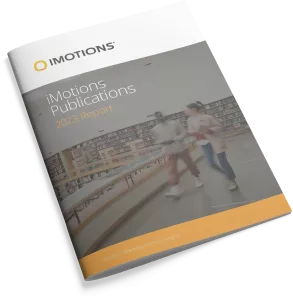-
Development of Dynamic Testing Methods Using Facial Expression Analysis to Evaluate Packaging Design in a Realistic Shopping Environment
Abstract: 80 to 95 percent of all new product launches fail (Dillon, 2011; Copernicus Marketing, Consulting, and Research, 2013). However, businesses can increase the chances of a successful product launch by better understanding consumer preferences and wants. Research done by McKinsey and Company shows that “more than 80 percent of top performers periodically tested and […]
-
Evaluations That Matter: Customer Preferences Using Industry-Based Evaluations and Eye-Gaze Data
Abstract: This study is the first stage of a research program aimed at understanding differences in how people process 2D and 3D automotive stimuli, using psychophysiological tools such as galvanic skin response (GSR), eye tracking, electroencephalography (EEG), and facial expressions coding, along with respondent ratings. The current study uses just one measure, eye tracking, and […]
-
The Effects of Self-Control on Subsequent Purchasing Decisions
The effect of self-control on individual behavior has long been a subject of debate. The psychology literature has advanced three theories to explain self-control. However, those theories carry contradictory predictions as they were restricted to linear relationships between an initial act of self-control and subsequent self-control ability. This study uses biometric measures collected in a […]
-
The Impact of Reviews and Average Rating on Hotel-Booking-Intention: A Qualitative Study
Abstract: User-generated information types (ratings and reviews) are highly used when booking hotel rooms on Online Travel Agency (OTA) websites. The impact of user-generated information on decision-making is often investigated through quantitative research, thereby not examining in depth how and why travelers use this information. This paper therefore presents a qualitative study conducted to achieve […]
-
Detecting Student Emotions in Computer-Enabled Classrooms
Abstract: Affect detection is a key component of intelligent educational interfaces that can respond to the affective states of students. We use computer vision, learning analytics, and machine learning to detect students’ affect in the real-world environment of a school computer lab that contained as many as thirty students at a time. Students moved around, […]
-
A Quantitative Way for Measuring the Building User Design Feedback and Evaluation
Computers are not smart enough yet to design and thus alleviate the need for a designer, although they can offer various possibilities of assistant to the designer. Various learning techniques provided in machine learning and artificial intelligence, such as dynamic programming and reinforcement learning, are making computers smarter at so many of the tasks humans […]
-
The Forensic Biometric Analysis of Emotions from Facial Expressions and Physiological Processes from the Heart and Skin
Abstract: Decision-making, perception, memory and social interactions are greatly driven by emotion. Emotions can be measured from facial expressions through the facial muscles. A group of four students were exposed to emotionally loaded stimuli (videos and images) in its full complexity to assess the valence of the emotional expression, the associated arousal, skin respiration and […]
-
Predicting User Learning Performance From Eye Movements During Interaction With a Serious Game
Abstract: This paper explored the relationship between eye movements’ measures and learners’ performance during interaction with Crystal Island, a narrative-centered learning game environment. We gathered gaze data from 20 participants using Tobii Tx300 eye tracker while they were reading books and answering multiple-choices quizzes. Statistical analysis as well as classifications were performed. Random forest classifier […]
-
Unique Object Characteristics Differentially Affect Visual Attention During Viewing of Dynamic Stimuli: The Influence of Location and Luminosity
Abstract: Understanding which characteristics of dynamic stimuli affect visual attention is crucial to usability research. We explored how object location and object luminosity differentially affect visual attention. Thirty-seven American participants viewed 34 Australian commercials, which were broken down by scene (N = 606) to identify all pertinent Areas of Interest (NAOIs = 2,695). Each AOI […]
-
Towards Biometric Assessment of Audience Affect
Abstract: This paper investigates how reliable affective responses can be obtained using objective biometric measures for media audience research. We use Galvanic Skin Response (GSR) to detect sixteen respondents’ arousal levels and as an objective measure to show how self-reporting disrupts the experience of respondents watching video content. The subjective experiences from nine subjects were […]
Research Report 2023
In-depth look at the scientific landscape as powered by iMotions software, showcasing groundbreaking research and the impact of our tools in various scientific and industrial fields.

Share Your Research

850+ universities worldwide with an iMotions human behavior lab
73 of the top 100 highest ranked universities
710+ published research papers using iMotions
iMotions is used for some of the most interesting human behavior research studies carried out by top researchers around the world. Contact us to have your publication featured here.
The authors of these publications have used iMotions as a software tool within their research.
“Software should be cited on the same basis as any other research product such as a paper or a book; that is, authors should cite the appropriate set of software products just as they cite the appropriate set of papers” (Katz et al., 2020).
We therefore encourage you to cite the use of iMotions where appropriate.
How to cite iMotions
APA
iMotions (10), iMotions A/S, Copenhagen, Denmark, (2024).
Note: adjust the version and year where relevant.
5 Most Popular Blogs
Learn How to Conduct Human Behavior Research with iMotions
Publications
Read publications made possible with iMotions
Blog
Get inspired and learn more from our expert content writers
Newsletter
A monthly close up of latest product and research news





